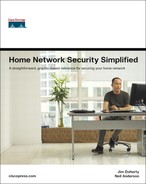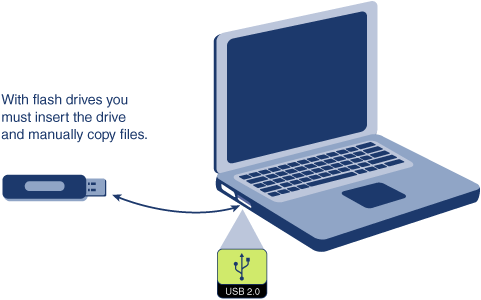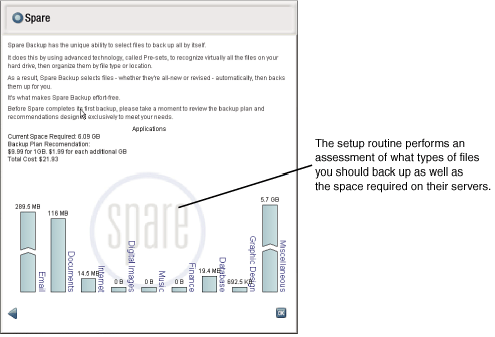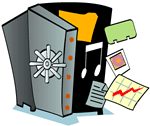
Threat Type: Software based, victim enabled
Examples of Threats:
A computer virus destroying or corrupting several of your files
Failure of your computer hard drive
Inadvertently deleting a file or folder
Our Tips:
Back up the data on your computer periodically.
Store files in your computer under a common file folder (with subfolders, of course) to make it easy to identify your information from the operating system and program files.
Backing up your files is not so much a security measure as it is a good policy against losing important files in the event that you are the victim of a virus or other security breech. It allows you to restore files and bring your computer back to a “previrus” state should you get infected and be unable to remove the virus via a security program. It also keeps you from jumping off a cliff should you be the victim of a hard drive crash that renders all your files inaccessible or destroyed.
Until recently, backing up your system was a complicated and sometimes expensive proposition. Today, storage is inexpensive, and automated back up methods make it easy to do. Still, most people (at least the ones not yet burned by a hard drive crash) simply do not bother with it.
Losing critical (or irreplaceable) files is a painful way to learn about the importance and ease of backing up your files. Storage is cheap, and backing up is easy. This is no different from getting screened for a disease that runs in your family. Early prevention is much cheaper and less painful than trying to fix the situation after you are afflicted.
When considering a plan for file or system backup, three questions need to be answered: what to back up, where to back up to, and how often to back up. These questions are answered in the rest of this chapter.
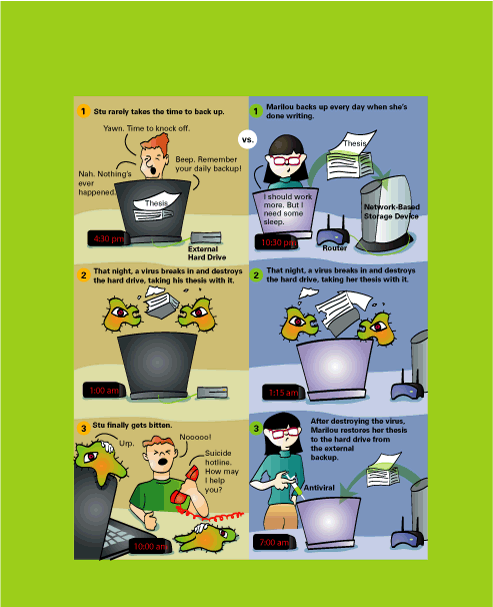
There are many, many files on your computer. Which should be backed up? Files can be grouped into three basic types of data files, or tiers: critical files, user files, and system files/programs. Let’s take a look at each:
Critical files—. These are the files that you simply cannot lose. It could be your list of clients, the transcript of your memoirs, digital photos, key work files, or whatever—any files that would cause you financial ruin, great heartache, or years of work if they were suddenly and irrevocably gone. In most cases, critical files would be those that are updated from time to time, perhaps the exception being photos or other files saved for posterity.
User files—. This class of files includes all the files created on your computer or via another program. This includes documents, presentations, e-mails, spreadsheets, and so on. Any file on your computer today that was not there the day you bought it (outside of program files) falls into this category.
Very Important
In many cases, a critical file can also be defined as a user file. The distinction is really up to you. For example, a person could have two documents, each with a recipe. One recipe came from FoodTV.com, and the other is the only documented recipe of your grandmother’s award-winning rutabaga pie. Clearly, there is a difference in the personal value of these two files, so you should have at least some form of backup for the recipe that cannot be replaced.
System files—. This is pretty much everything else on your computer, including the operating system and programs that have been installed.
So, which should you back up? Well, it depends on how much storage you have at your disposal and how quickly you need to be up and running in the event of a problem.
At a minimum, every person who owns a computer should back up critical files. We have seen lives in ruins because of one or two files (determined to be critical after the fact) that were lost or destroyed. Some examples of key files to back up are as follows:
Financial records
Digital photographs
Downloaded music
Personal project files
Your e-mail address book
Saved e-mails
Given that storage is relatively cheap, you should err on the side of designating many files as critical as opposed to being stingy with the critical designation. We recommend that you back up all critical files and user files. Whereas losing all the noncritical files would not push anyone to the brink, it really is a giant pain in the rear end to replace them all or live without them.
Should you back up the operating system and program files? It depends. Most often, you have the CD for the operating system, and either CDs for all the programs you have installed or they are easily downloadable online. If you cannot afford to be without your computer for a day or so while you restore it from CDs, backing up the system and program files is a smart move.
Instead of selecting the subset of files you really need to back up, a final option is to back up the entire system. This is not for everyone because it takes some time and a lot of storage; if you run a business using your computer or cannot afford to be without your computer for a day, however, you might want to think about this option. The most convenient way to back up an entire system is to make a drive image, which is essentially a compressed copy of every bit on your computer. A drive image will cost you a few dollars, but it might be worth it for the piece of mind it provides.
Where to back up files to really depends on what you decide you need to back up, and in this case “where” includes both the device (as in the thing you put the bits and bytes on) and the location (as in where do you put the thing that you put the bits and bytes on):
The device—. For critical files, which for the sake of discussion we assume is a handful of relatively small files (the total is less than 1 GB, for example), you are probably okay with using a memory key (we discuss these and other devices later in this chapter) or an online service. For all the user files or a system image backup, you probably ought to consider a zip drive. Zip drives have storage ranges from a few to hundreds of GB of memory. We walk through a couple of user scenarios later in this chapter. There is also the option of installing a second internal hard drive onto your computer; because this means opening your computer, however, we recommend that you avoid this option (and we’re not going to tell you how to do it anyway).
The location—. Where you keep your storage media depends on how safe you want or need the data to be. For critical files, you should keep your backed up data in a different physical location than your PC. This prevents a disaster (a house fire or earthquake, for example) from destroying both your PC and your backed-up files (unless, of course, it is a really big fire or earthquake, in which case your stored files will not be much of a concern to anyone but future archeologists). There are a couple of backup strategies here: “store-and-port” options, in which you back up and then relocate the storage media; and “online” backup, whereby you upload your files to an Internet server far away from where you are.
How often you back up depends on what you are backing up, where you are backing up to, and how often you make changes to the files you back up. For critical files, it really depends on how often you are making changes to them. User files and system files should usually be backed up weekly. A good rule of thumb is that you never want to lose more than a full week of work re-creating updates to files that were lost. For critical files, you do not want to lose more than a day (assuming that it is a working file which changes often). If you are using an automated backup system, it is easy to set it up for automatic daily backups, which could save you a lot of time and aggravation later.
You have a wide range of storage methods available. The one (or ones) you choose largely depends on how much data you have and how critical your data is. The following sections cover the most common methods and provide some guidance on the right storage method for different situations.
Flash memory, also called memory sticks or USB keys, are a fast and convenient way to store files and provide some level of back up, usually for critical files. They are also small enough to be carried on a key chain. Flash memories come in a number of styles and sizes, and many of the newer ones can be password protected. Some are even designed to withstand extreme physical stress and still maintain their functionality. One of the new trends in Flash memory is biometric security. Access to these memory devices can only be gained by swiping your finger print over the reader. Security measures on such devices is great for secure or private data, but do not forget your password (or lose your finger) because without it the data will be unretrievable. If you do store critical or private information on one of these keys, we suggest spending the extra money to get one with some level of security in case you lose it somewhere.
The available memory on Flash drives is growing, and some Flash drives have up to 32 GB of storage. These are great devices for storing critical files, especially ones that need to be transported. You can also keep these drives in a fire box or safe-deposit box or some other location so that the same disaster does not destroy your computer and backup device. If you do so, be sure to plug the Flash drive into a USB port on a computer once in a while (we are talking once every four to six months, not every week) to ensure the tiny battery inside the Flash device maintains a charge and to make sure the files are still operable (a spot check of one or two files is sufficient). The internal batteries typically last a long time without charging (recharging is automatic when you plug them into your USB port), but read the manual just so you know how long your Flash drive can go without a connection. Backing up to a Flash drive must be done manually, but it is just a matter of copying files from where they are to the Flash drive folder. Figure 9-1 shows where the Flash drive goes.
We mentioned earlier that it is a good idea to keep all your critical files in a common folder. This makes backing up much faster and easier. Just create a folder called “important stuff” (or whatever works for you) somewhere on your computer. After you have created this folder, move all the folders and files that you have designated as critical to that folder. Now, when you back up, you only need to copy the “important stuff” folder onto the memory key.
There are a lot of choices for consumers here and a wide array of choices regarding size, shape, security, color, and so on. A great resource for sorting all of this out is http://www.cnet.com, where you can read through their ratings on Flash drives and every product type mentioned here (and a bunch that are not). It is a good idea to check here before buying tech gear.
External hard drives or zip drives are also great solutions for backing up your files. The capacity of these devices range from tens to hundreds of GBs. You can use them for backing up a few files, all files on a PC, or even for backing up all files on multiple PCs. These drives can also serve double duty by storing massive amounts of digital media, such as digital photos, music, and video libraries on a network.
There are a number of different ways to use external drives, but for backups the best drive on the market is the Maxtor OneTouch (most of the products similar to the OneTouch are good, too). After the initial setup of this device, you literally touch one button on the device to back up your system. There are other options, too, for automated backup in both Windows XP and Windows 98, both of which are shown later in this chapter.
Many of these devices come with both USB and Firewire connections. If your PC has a Firewire port, you will want to use that because the access speed to the storage device is much faster over Firewire than USB.
The downside to these devices is that to have an automated backup process (which is always preferred because you will forget to do it manually), you need to have the device dedicated to a single PC. If you only have one PC that needs backing up, this is no problem; if you have a multi-PC home, however, you must manually move the device from PC to PC to back them up, or buy one external drive per PC, which could get expensive. Figure 9-2 demonstrates how these drives are attached.
One solution to the problem of having multiple computers to back up is to set up a network storage drive. These drives work just like an external hard drive, except that they are connected to your home network device (a wired or wireless router/switch) and can therefore be accessed by all PCs on the network. This is a great setup because you can set up an automated backup routine on all your PCs so that once a week (or at any interval you like) they perform a backup function to the network drive.
With the larger-capacity network storage drives, you can also use the drives as file servers so that all the PCs on the network can access shared digital media libraries, such as digital photos, music, and videos.
Finally, some of the network storage devices can also double as print servers. Figure 9-3 show how these devices connect into your home network.
Two recommended options for network storage devices are the Linksys attached storage devices and the Buffalo LinkStation drive. If you want to use an existing hard drive, you can also use a network storage link that converts a standard storage device to a network attached storage.
Very Important
If you do choose the network storage option, your network performance will be noticeably slower during system backups. To avoid any annoying slowdowns, be sure to schedule your backups when the network is not otherwise being used.
Very Important
The Linksys NSLU2 is a nice device for converting a standard USB storage device to a network device, but it does require a full reformatting of the storage device. So, if you have data on the drive you want to keep, you need to temporarily store the data on a PC or another hard drive during the reformatting; otherwise, all your data on the device will be lost. This is a cool device, though, because you can take a USB key or external hard drive and then plug the NSLU2 device to your router and your network-based storage. The device is also expandable, so you can connect more than one external hard drive.
One of the newest options for storage is online storage. Online storage involves you backing up your data over your broadband connection, over the Internet, to a remote company that has many, many file servers (big computers with big storage drives). With these services, your data is stored in several data centers providing backup and geographic separation of all you back up. This is equivalent to what large companies do today for their critical corporate data. Figure 9-4 shows an example.
A number of companies offer this service. One service, Spare Backup, in addition to all the benefits of the other services, offers a user-friendly introduction and does not require a credit card for the free trial until you actually sign up. Very nice:
This site also has a feature that assesses what on your PC should be backed up, and they make it pretty easy to customize your backup routine. Figures 9-5, 9-6, and 9-7 provide screen shots of the setup where you select which files to back up.
Pricing for this service is about the same as other services (the annual fee for 1 GB is about $95), but with this service you can add 1 GB at a time to meet your specific backup needs. Most other services only have predefined tiers (so you pay for storage you do not use). The cost per additional GB per month is less than $2 if you sign up for the annual service.
There are also a number of other services to choose from, including the following:
Most of these sites also offer free trials of 30 days or so, which makes it easy to try them and pick the one that is right for you.
When it comes to online storage and backup, there are three strong advantages:
Online storage is portable, and you can get easy access to your key files without lugging a lot of gear around with you.
You are automatically protected from disasters that affect both your PC and your locally backed-up files.
You can easily set up regularly scheduled backups so that you do not need to remember to back up your files after the initial setup.
On the downside, online storage is relatively expensive compared to other forms of storage, ranging up to hundreds of dollars a year per GB, compared to just under $1 per GB for the external hard drives discussed earlier.
Weigh the critical nature of your files and the convenience you require.
We have found that the online backup services are (in general) secure and provide a good value for truly critical files. If you have data or files that absolutely, positively cannot be lost, an online storage option (in addition to other forms of backup) is the way to go. If you want some additional assurance on your other critical files, online backup services are also a good way to go if you do not mind spending the extra money for the added piece of mind.
The final alternative here is to back up your files to DVDs (or CDs) using a writable DVD (or CD) system. There are some advantages, including the ability to use the DVD system to both back up and to play music and movies. You can also store key files on disc and store them in a safe place without ever having to worry about shelf life (you will likely expire before the data does as long as you store the disks properly). Figure 9-8 show how a DVD-R drive connects.
Your computer most likely already has either a DVD or CD drive (check if it is writeable though). To use this method, either the computer manufacturer or DVD drive vendor supplies a software program that can be used to perform backups. It is a manual process, in which you need to decide and select which files to back up (and sit down and perform the backup periodically). But, the discs and drives are cheap, and this is a pretty common type of backup.
There is a way to run backup routines from multiple folders or even multiple computers onto CDs, but we do not think this is a good option for most people. It is much easier to move the files to a central folder and then back up that one folder.
Table 9-1 provides a summary of all the options for backup and storage.
Table 9-1. Storage Summary Table
Storage/Backup Type | Best Used For | Advantages | Disadvantages | Cost/GB |
|---|---|---|---|---|
Flash drive | A few critical files | Flash drives are quick and easy to use and are portable. Memory on these devices is as high as 32 GB at publication time. Everyone should have one of these. | Backup cannot be automated and memory is limited (although increasing every day). Newer devices provide security but most have no security at all. | $50-$100/GB |
External hard drive | Backing up user files on a regular basis | Provides massive amounts of storage, and backup routines can be automated. | Because they are co-located with the PC, any disaster that destroys your PC will destroy your backup, too. | ~$1/GB |
Backing up users files from several PCs | All the advantages of an external hard drive plus the ability to back up more than one PC with the same device. | Network storage devices are a bit more complex to set up than external hard drives. | ~$1.50/GB | |
Online storage/backup | Backing up critical files | Probably the safest way to store your data and closest a home user will get to corporate-level backup without spending a ton of money. | The only downside to this type of backup is the cost. It is a great way to back up your files, but you have to pay more for it. | $75-$150/GB per year |
DVD-R | Backing up large amounts of data that does not change often (such as music files) | DVD-Rs are a relatively inexpensive form of backup. Once backed up, the disks can be stored just about anywhere and retrieved only when needed. | DVD-R backup cannot really be automated. This is not a good option for backing up files that are updated frequently. | Writers cost between $70-$150. Discs are cheap. |
In this section, we walk through a possible scenario for two different users to give you an idea or two on which methods would work best for you. Let’s take a look at two user profiles:
User 1 profile—. User 1 is a college student. He wants to back up his files about once per week. He has several gigabytes of music files that he has purchased over the years, most of which are stored on an external hard drive today. User 1 uses his PC mostly to work on his Master’s thesis, which if lost, would basically end his life. This user wants to safely back up his music and store it all away from his apartment. He also wants to keep his thesis work backed up (which is updated often). Because he has an external hard drive, he also wants to back up his user files.
User 2 Profile—. User 2 is a homeowner with a spouse and a teenager. All three people in the house have a dedicated PC, and she wants to back them all up onto a single device. She also has about 1 GB of critical files that she wants to keep backed up and very secure.
First let’s look at User 1. Given that User 1 already has an external hard drive, he decides to back up his user files directly to this hard drive. If his PC gets infected with a virus, his files can all be recovered. In addition to backing up his PC files this way, he decides to borrow a friends DVD-R writer, and he stores all his music files on DVDs, which he keeps in a box in the trunk of his car. This way, if his apartment burns down, he still has all his music (which for a college kid is pretty important). Finally, because his degree and possibly his financial future depends on his thesis, he decides to back up these files on his external hard drive, but he also keeps an updated copy on a Flash drive, which he keeps attached to his keychain. The Flash drive is both password protected and has a fingerprint ID so that if he loses the Flash drive no one will be able to view or steal his work.
Next let’s look at User 2. This user needs to back up more than one PC, so she uses a network-based storage device that plugs directly into the back of her wireless router. A backup routine is set up in Windows XP, and now wherever the PCs in the home happen to be (as long as it is in range of the router), the backup routines will back up everyone’s files to the network storage device. This user also has some very important files and to be as certain as possible that no harm will come to them she subscribes to an online backup and storage service. She pays an annual fee of $150, which is expensive, but she has the piece of mind that whatever she backs ups to this service is as safe as a file can be.
If you happen to use a device suitable for automated backup, but it does not come with a software program that allows you to set up an automated backup routine, you can easily set it up yourself using Windows XP. The basic steps are outlined as follows (the following procedure is based on Microsoft’s website located at http://www.microsoft.com/athome/security/update/howbackup.mspx):
Click Start>All Programs>Accessories>System Tools, and then click Backup to start the wizard.
Very Important
If you are using XP Professional, the backup program should be preloaded. If you have XP Home edition and you did not see anything called Backup in Step 1, you will have to install it from your XP CD. Click Perform Additional Tasks>Browse This CD. This will bring up an Explorer window. Click the following folders:
Value Add > MFST > Ntbackup
When you are in this folder, double-click the Ntbackup.msi file, which will install the backup program.
Click Next to skip past the opening page, choose Back up files and settings from the second page, and then click Next.
Choose which files or folders you want to back up. You are given several choice here. If you want to back up only select files or folders, click the Let me choose what to back up button.
Choose where you want the data backed up to. This will likely be the name of the device connected to your PC or on the network. You also need to create a name for the backup.
Set your schedule. Click the Advanced button and then Next and you will see a schedule window.
We realize that backing up files might not be the most exciting thing to think about, but as we stated, memory is inexpensive and backup routines can be easily automated.
Do not make the mistake of waiting for a massive computer crash, hard disk failure, or rogue virus (or even accidental deletion) to learn how easy it is to back up your files (or how painful it is when you lose all your stuff). It is much better to be that smug person who tells the person who just did lose all his files that you back up your stuff and that it is easy.
If you have any problems with backup procedures, both Microsoft and Apple have good user help pages on their corporate sites. Just go to http://www.microsoft.com or http://www.apple.com (on the Apple site, click the Support tab) and search for “backing up files” or whatever else you need help with, and a slew of articles and help files will appear.
